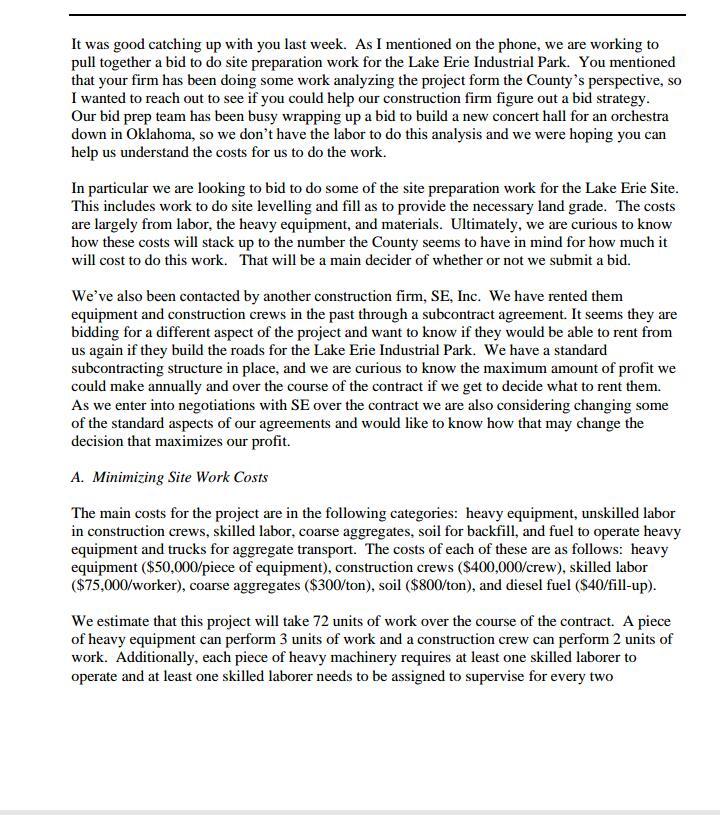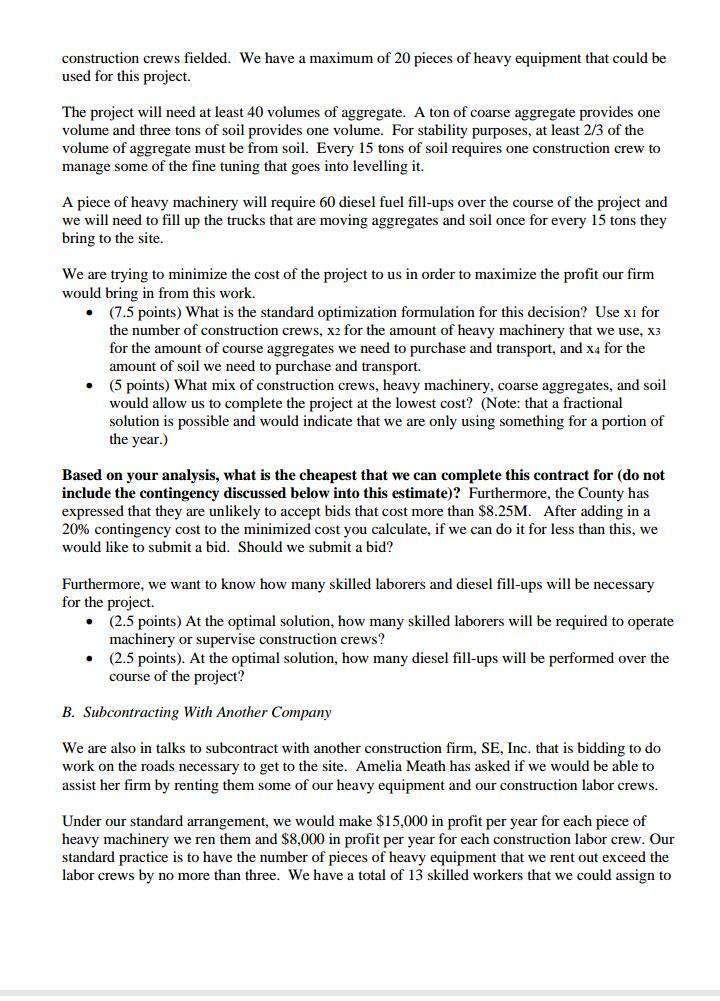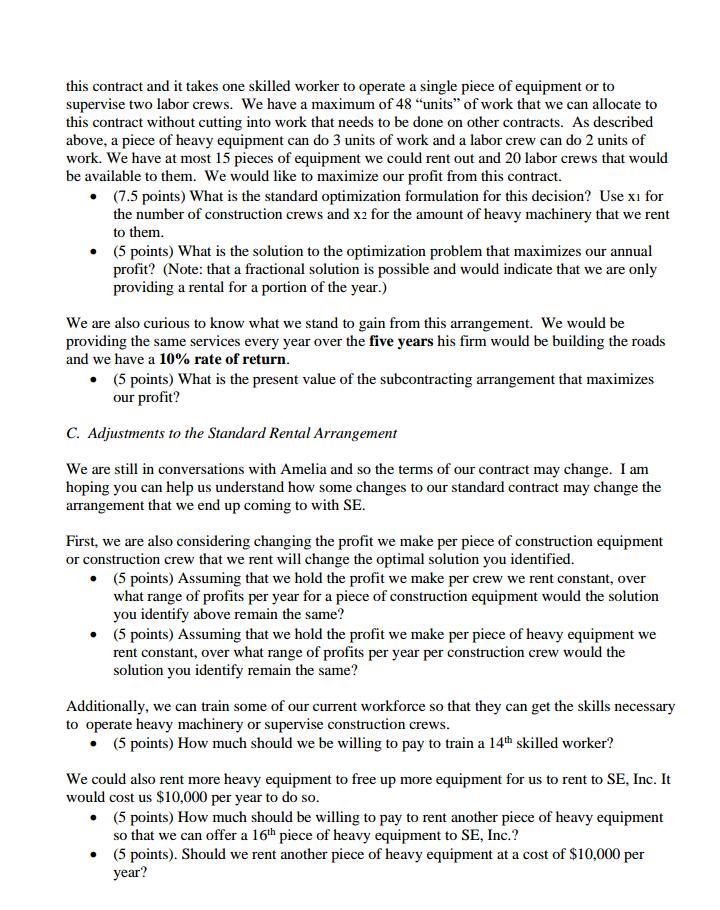


It was good catching up with you last week. As I mentioned on the phone, we are working to pull together a bid to do site preparation work for the Lake Erie Industrial Park. You mentioned that your firm has been doing some work analyzing the project form the County's perspective, so I wanted to reach out to see if you could help our construction firm figure out a bid strategy. Our bid prep team has been busy wrapping up a bid to build a new concert hall for an orchestra down in Oklahoma, so we don't have the labor to do this analysis and we were hoping you can help us understand the costs for us to do the work. In particular we are looking to bid to do some of the site preparation work for the Lake Erie Site. This includes work to do site levelling and fill as to provide the necessary land grade. The costs are largely from labor, the heavy equipment, and materials. Ultimately, we are curious to know how these costs will stack up to the number the County seems to have in mind for how much it will cost to do this work. That will be a main decider of whether or not we submit a bid. We've also been contacted by another construction firm, SE, Inc. We have rented them equipment and construction crews in the past through a subcontract agreement. It seems they are bidding for a different aspect of the project and want to know if they would be able to rent from us again if they build the roads for the Lake Erie Industrial Park. We have a standard subcontracting structure in place, and we are curious to know the maximum amount of profit we could make annually and over the course of the contract if we get to decide what to rent them. As we enter into negotiations with SE over the contract we are also considering changing some of the standard aspects of our agreements and would like to know how that may change the decision that maximizes our profit. A. Minimizing Site Work Costs The main costs for the project are in the following categories: heavy equipment, unskilled labor in construction crews, skilled labor, coarse aggregates, soil for backfill, and fuel to operate heavy equipment and trucks for aggregate transport. The costs of each of these are as follows: heavy equipment ($50,000/piece of equipment), construction crews ($400,000/crew), skilled labor ($75,000/worker), coarse aggregates ($300/ton), soil ($800/ton), and diesel fuel (S40/fill-up). We estimate that this project will take 72 units of work over the course of the contract. A piece of heavy equipment can perform 3 units of work and a construction crew can perform 2 units of work. Additionally, each piece of heavy machinery requires at least one skilled laborer to operate and at least one skilled laborer needs to be assigned to supervise for every two construction crews fielded. We have a maximum of 20 pieces of heavy equipment that could be used for this project. The project will need at least 40 volumes of aggregate. A ton of coarse aggregate provides one volume and three tons of soil provides one volume. For stability purposes, at least 2/3 of the volume of aggregate must be from soil. Every 15 tons of soil requires one construction crew to manage some of the fine tuning that goes into levelling it. A piece of heavy machinery will require 60 diesel fuel fill-ups over the course of the project and we will need to fill up the trucks that are moving aggregates and soil once for every 15 tons they bring to the site. We are trying to minimize the cost of the project to us in order to maximize the profit our firm would bring in from this work. (7.5 points) What is the standard optimization formulation for this decision? Use x1 for the number of construction crews, x2 for the amount of heavy machinery that we use, x3 for the amount of course aggregates we need to purchase and transport, and x4 for the amount of soil we need to purchase and transport. (5 points) What mix of construction crews, heavy machinery, coarse aggregates, and soil would allow us to complete the project at the lowest cost? (Note: that a fractional solution is possible and would indicate that we are only using something for a portion of the year.) Based on your analysis, what is the cheapest that we can complete this contract for (do not include the contingency discussed below into this estimate)? Furthermore, the County has expressed that they are unlikely to accept bids that cost more than $8.25M. After adding in a 20% contingency cost to the minimized cost you calculate, if we can do it for less than this, we would like to submit a bid. Should we submit a bid? . Furthermore, we want to know how many skilled laborers and diesel fill-ups will be necessary for the project. (2.5 points) At the optimal solution, how many skilled laborers will be required to operate machinery or supervise construction crews? (2.5 points). At the optimal solution, how many diesel fill-ups will be performed over the course of the project? . B. Subcontracting With Another Company We are also in talks to subcontract with another construction firm, SE, Inc. that is bidding to do work on the roads necessary to get to the site. Amelia Meath has asked if we would be able to assist her firm by renting them some of our heavy equipment and our construction labor crews. Under our standard arrangement, we would make $15,000 in profit per year for each piece of heavy machinery we ren them and $8,000 in profit per year for each construction labor crew. Our standard practice is to have the number of pieces of heavy equipment that we rent out exceed the labor crews by no more than three. We have a total of 13 skilled workers that we could assign to this contract and it takes one skilled worker to operate a single piece of equipment or to supervise two labor crews. We have a maximum of 48 "units of work that we can allocate to this contract without cutting into work that needs to be done on other contracts. As described above, a piece of heavy equipment can do 3 units of work and a labor crew can do 2 units of work. We have at most 15 pieces of equipment we could rent out and 20 labor crews that would be available to them. We would like to maximize our profit from this contract. (7.5 points) What is the standard optimization formulation for this decision? Use x1 for the number of construction crews and x2 for the amount of heavy machinery that we rent to them. (5 points) What is the solution to the optimization problem that maximizes our annual profit? (Note: that a fractional solution is possible and would indicate that we are only providing a rental for a portion of the year.) We are also curious to know what we stand to gain from this arrangement. We would be providing the same services every year over the five years his firm would be building the roads and we have a 10% rate of return. (5 points) What is the present value of the subcontracting arrangement that maximizes our profit? C. Adjustments to the Standard Rental Arrangement We are still in conversations with Amelia and so the terms of our contract may change. I am hoping you can help us understand how some changes to our standard contract may change the arrangement that we end up coming to with SE. First, we are also considering changing the profit we make per piece of construction equipment or construction crew that we rent will change the optimal solution you identified. (5 points) Assuming that we hold the profit we make per crew we rent constant, over what range of profits per year for a piece of construction equipment would the solution you identify above remain the same? (5 points) Assuming that we hold the profit we make per piece of heavy equipment we rent constant, over what range of profits per year per construction crew would the solution you identify remain the same? Additionally, we can train some of our current workforce so that they can get the skills necessary to operate heavy machinery or supervise construction crews. (5 points) How much should we be willing to pay to train a 14h skilled worker? We could also rent more heavy equipment to free up more equipment for us to rent to SE, Inc. It would cost us $10,000 per year to do so. (5 points) How much should be willing to pay to rent another piece of heavy equipment so that we can offer a 16th piece of heavy equipment to SE, Inc.? (5 points). Should we rent another piece of heavy equipment at a cost of $10,000 per year? . It was good catching up with you last week. As I mentioned on the phone, we are working to pull together a bid to do site preparation work for the Lake Erie Industrial Park. You mentioned that your firm has been doing some work analyzing the project form the County's perspective, so I wanted to reach out to see if you could help our construction firm figure out a bid strategy. Our bid prep team has been busy wrapping up a bid to build a new concert hall for an orchestra down in Oklahoma, so we don't have the labor to do this analysis and we were hoping you can help us understand the costs for us to do the work. In particular we are looking to bid to do some of the site preparation work for the Lake Erie Site. This includes work to do site levelling and fill as to provide the necessary land grade. The costs are largely from labor, the heavy equipment, and materials. Ultimately, we are curious to know how these costs will stack up to the number the County seems to have in mind for how much it will cost to do this work. That will be a main decider of whether or not we submit a bid. We've also been contacted by another construction firm, SE, Inc. We have rented them equipment and construction crews in the past through a subcontract agreement. It seems they are bidding for a different aspect of the project and want to know if they would be able to rent from us again if they build the roads for the Lake Erie Industrial Park. We have a standard subcontracting structure in place, and we are curious to know the maximum amount of profit we could make annually and over the course of the contract if we get to decide what to rent them. As we enter into negotiations with SE over the contract we are also considering changing some of the standard aspects of our agreements and would like to know how that may change the decision that maximizes our profit. A. Minimizing Site Work Costs The main costs for the project are in the following categories: heavy equipment, unskilled labor in construction crews, skilled labor, coarse aggregates, soil for backfill, and fuel to operate heavy equipment and trucks for aggregate transport. The costs of each of these are as follows: heavy equipment ($50,000/piece of equipment), construction crews ($400,000/crew), skilled labor ($75,000/worker), coarse aggregates ($300/ton), soil ($800/ton), and diesel fuel (S40/fill-up). We estimate that this project will take 72 units of work over the course of the contract. A piece of heavy equipment can perform 3 units of work and a construction crew can perform 2 units of work. Additionally, each piece of heavy machinery requires at least one skilled laborer to operate and at least one skilled laborer needs to be assigned to supervise for every two construction crews fielded. We have a maximum of 20 pieces of heavy equipment that could be used for this project. The project will need at least 40 volumes of aggregate. A ton of coarse aggregate provides one volume and three tons of soil provides one volume. For stability purposes, at least 2/3 of the volume of aggregate must be from soil. Every 15 tons of soil requires one construction crew to manage some of the fine tuning that goes into levelling it. A piece of heavy machinery will require 60 diesel fuel fill-ups over the course of the project and we will need to fill up the trucks that are moving aggregates and soil once for every 15 tons they bring to the site. We are trying to minimize the cost of the project to us in order to maximize the profit our firm would bring in from this work. (7.5 points) What is the standard optimization formulation for this decision? Use x1 for the number of construction crews, x2 for the amount of heavy machinery that we use, x3 for the amount of course aggregates we need to purchase and transport, and x4 for the amount of soil we need to purchase and transport. (5 points) What mix of construction crews, heavy machinery, coarse aggregates, and soil would allow us to complete the project at the lowest cost? (Note: that a fractional solution is possible and would indicate that we are only using something for a portion of the year.) Based on your analysis, what is the cheapest that we can complete this contract for (do not include the contingency discussed below into this estimate)? Furthermore, the County has expressed that they are unlikely to accept bids that cost more than $8.25M. After adding in a 20% contingency cost to the minimized cost you calculate, if we can do it for less than this, we would like to submit a bid. Should we submit a bid? . Furthermore, we want to know how many skilled laborers and diesel fill-ups will be necessary for the project. (2.5 points) At the optimal solution, how many skilled laborers will be required to operate machinery or supervise construction crews? (2.5 points). At the optimal solution, how many diesel fill-ups will be performed over the course of the project? . B. Subcontracting With Another Company We are also in talks to subcontract with another construction firm, SE, Inc. that is bidding to do work on the roads necessary to get to the site. Amelia Meath has asked if we would be able to assist her firm by renting them some of our heavy equipment and our construction labor crews. Under our standard arrangement, we would make $15,000 in profit per year for each piece of heavy machinery we ren them and $8,000 in profit per year for each construction labor crew. Our standard practice is to have the number of pieces of heavy equipment that we rent out exceed the labor crews by no more than three. We have a total of 13 skilled workers that we could assign to this contract and it takes one skilled worker to operate a single piece of equipment or to supervise two labor crews. We have a maximum of 48 "units of work that we can allocate to this contract without cutting into work that needs to be done on other contracts. As described above, a piece of heavy equipment can do 3 units of work and a labor crew can do 2 units of work. We have at most 15 pieces of equipment we could rent out and 20 labor crews that would be available to them. We would like to maximize our profit from this contract. (7.5 points) What is the standard optimization formulation for this decision? Use x1 for the number of construction crews and x2 for the amount of heavy machinery that we rent to them. (5 points) What is the solution to the optimization problem that maximizes our annual profit? (Note: that a fractional solution is possible and would indicate that we are only providing a rental for a portion of the year.) We are also curious to know what we stand to gain from this arrangement. We would be providing the same services every year over the five years his firm would be building the roads and we have a 10% rate of return. (5 points) What is the present value of the subcontracting arrangement that maximizes our profit? C. Adjustments to the Standard Rental Arrangement We are still in conversations with Amelia and so the terms of our contract may change. I am hoping you can help us understand how some changes to our standard contract may change the arrangement that we end up coming to with SE. First, we are also considering changing the profit we make per piece of construction equipment or construction crew that we rent will change the optimal solution you identified. (5 points) Assuming that we hold the profit we make per crew we rent constant, over what range of profits per year for a piece of construction equipment would the solution you identify above remain the same? (5 points) Assuming that we hold the profit we make per piece of heavy equipment we rent constant, over what range of profits per year per construction crew would the solution you identify remain the same? Additionally, we can train some of our current workforce so that they can get the skills necessary to operate heavy machinery or supervise construction crews. (5 points) How much should we be willing to pay to train a 14h skilled worker? We could also rent more heavy equipment to free up more equipment for us to rent to SE, Inc. It would cost us $10,000 per year to do so. (5 points) How much should be willing to pay to rent another piece of heavy equipment so that we can offer a 16th piece of heavy equipment to SE, Inc.? (5 points). Should we rent another piece of heavy equipment at a cost of $10,000 per year









